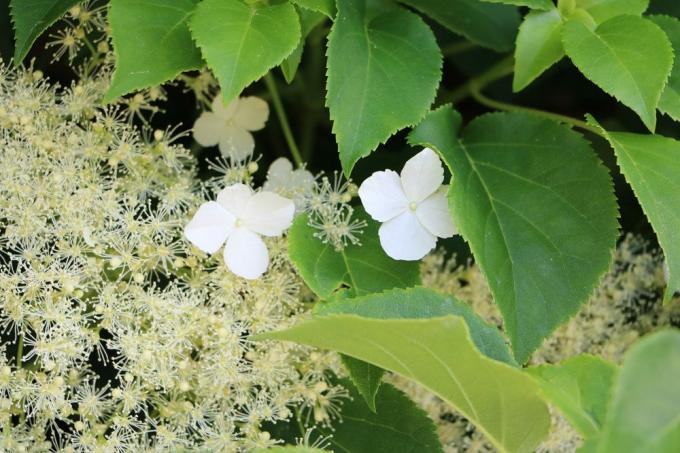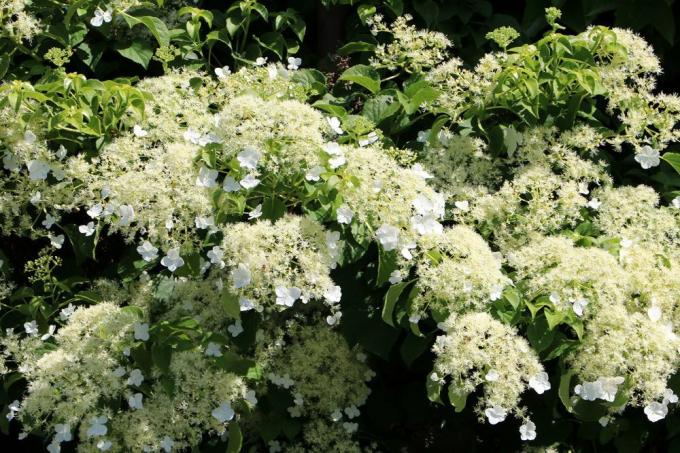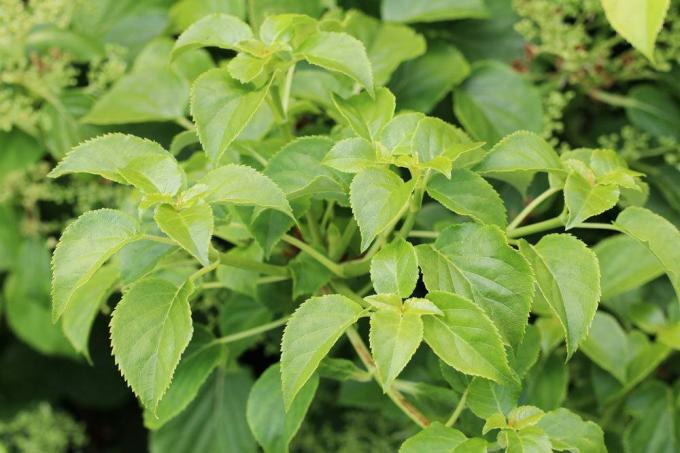
table of contents
- Ideal location for climbing hydrangeas
- Climbing aid
- floor
- Sun and shade
- humidity
- Consider possible location problems
- Allergy sufferers, pets and children
- Location in winter
the Climbing hydrangea is characterized by a lush flower dress. An ideal location is a basic prerequisite for this to develop and for healthy, vigorous growth to take place. Find out what this looks like.
Ideal location for climbing hydrangeas
One of the most important site conditions is the space available for climbing hydrangeas. They can be up to twelve meters high and five meters wide. So that their growth is not disturbed, the planting distance in the garden bed should be at least five meters. It is tighter when other climbing plants rise, such as the clematis (clematis). This can be placed at a distance of about two meters if socialization is desired. Above all, attention should be paid to gutters, because climbing hydrangeas can damage them with their tendrils and clog drains. The "problem" can, of course, be solved by cutting regularly.

Climbing aid
If the climbing hydrangea is to grow upwards in a "controlled" manner, a climbing aid is a good choice. When choosing the ideal place, it should be ensured that the climbing aid has space and support. Freestanding climbing aids can be stabilized in the ground. They are accordingly less suitable for terraces if drill holes / anchors are not to be used. It is easier with climbing aids that can be attached to walls / walls. Whether these have to be as wide as the tendril aid is a question of visual taste. In many cases, the tendril support protruding beyond the wall end is used on terraces to create a side screen or a "blooming" partition between two areas.
Note: The climbing hydrangea can damage the plaster and / or cause cracks on walls due to its fine roots when tendrils. A climbing aid reduces the risk, but does not offer a 100 percent guarantee that it will not be damaged.
floor
For the perfect choice of location, the nature of the soil should also be taken into account. Places where the soil is heavy and very calcareous are not suitable. Perfect locations for climbing hydrangeas meet the following soil conditions:

- Rich in humus
- Fresh and easy
- Permeable to water
- Low-lime / lime-free
- PH value: below 7.0
- Rhododendron soil is suitable for potted plants
Tip: If you want a pink climbing hydrangea to turn blue, you should ensure a pH value between 4.0 and 4.5 in the soil. This enables the blue color to be achieved.
Sun and shade
The climbing hydrangea only grows robustly and can produce many flowers if the light conditions are optimal. Originally it is primarily found in forests, so that it “naturally” likes it to be shady. So it works without any sun.
The new location for the climbing hydrangea should have the following lighting conditions:

- Ideal: semi-shady
- Shady - location on north walls possible (usually less flower formation)
- Sun and bright, without direct sunlight (otherwise flowers and leaves will burn)
humidity
The Hydrangea petiolaris prefers a lot of moisture. On a slope, the water flows off faster than it pulls into the earth. There is a risk that the climbing hydrangea will not receive enough moisture and will dry out if the watering can is not used to give plenty of water.
Climbing hydrangeas do not tolerate waterlogging either. Therefore sinks do not offer a suitable location either. A level location is recommended so that rain and irrigation water does not run off too quickly in large quantities and waterlogging does not form.
Consider possible location problems
Fragrance sensitivity
Some like it, others don't: the scent of flowers. The climbing hydrangea offers plenty of this during the flowering period between May and June / July. It's sweet, tender and reminiscent of jasmine. Anyone who is sensitive to the scent of flowers or does not want to have it mixed up with the scent of other plants should adhere to the following location details:

- Make sure there is sufficient distance to the places where you are staying
- Avoid hydrangeas on small, narrow balconies
- If only the jasmine scent bothers: cover with a more pleasant scent (e.g. scented candles)
- Reduce flowers
Disturbance from bees
As soon as the first flowers of the climbing hydrangea open, it attracts bees, which use the plant as a source of food and remove the nectar from them. The bee gathering is great for nature, but not always for people. When choosing a location, you should consider the following:
- Place climbing hydrangeas further away from dining tables
- Dogs like to hunt bees / wasps - in the worst case, when eating there is a risk of suffocation due to swelling of the sting
- Playgrounds or sandpits should have sufficient distance from the plant
- Allergy sufferers: advisable to forego the hydrangea plants if there is no great distance between them
Allergy sufferers, pets and children
The climbing hydrangea is slightly toxic to all parts of the plant. It contains various toxins. These include, above all, hydrocyanic acid (glycosides).
children

The toxins can cause slight symptoms of poisoning in the form of dizziness and / or vomiting when parts of plants are consumed. This poses a certain danger to children. It can be assumed that children do not consume large amounts due to the unpleasant, bitter taste, causing more severe symptoms of poisoning, but the new location should still be subject to some conditions fulfill:
- Far away from children's playgrounds
- No possible access for children if they are unsupervised
Ideal:
- Plant in a raised bed where children cannot reach the plant
- Planting in the second row of beds with difficult access
- Draw a fence or similar around the plant as a demarcation
Allergy sufferers
The same as for children applies to allergy sufferers and people with sensitive skin. In addition, climbing hydrangeas can trigger a contact allergy when touched. Therefore:
- Choose a location where accidental contact cannot occur (narrow balconies, for example)
- In principle, wear gloves and clothing that cover skin during maintenance work
Dog, cat & Co.

However, special care is required when keeping pets. You should only choose locations where pets are not unattended. The toxins of the Hydrangea petiolaris often cause significantly more severe symptoms of poisoning in pets, such as:
- Shortness of breath
- diarrhea
- Vomit
- Circulatory problems
- In the worst case, cardiac arrest (if large amounts are consumed)
Location in winter
In the first three to four years of life and generally in the first winter after relocating, climbing hydrangeas make special demands on their locations:
- Wind-protected location selection
- Place cold protection on earth over the root area (leaves, straw, brushwood or pine needles)
-
Potted plants in principle move to a warmer environment at any age or:
- Cover the potted plants with fleece
- Place the bucket on insulation (e.g. cardboard or styrofoam)
- Wrap a thick layer of plastic film around the walls of the tub

